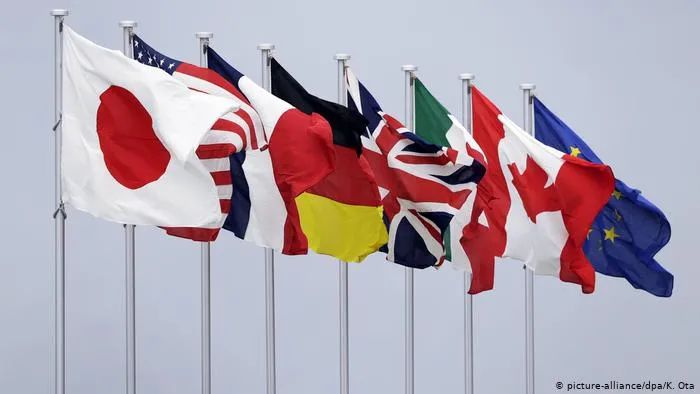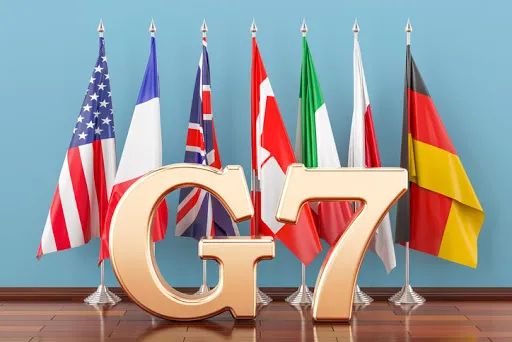The Western Group of Seven (G7) summit was held online today.
This is the first time that U.S. President Biden has “appeared” in major international multilateral occasions since he took office. It is the carefully designed debut of Biden in the new cabinet.
The White House previously said in a statement that the meeting will discuss the coronavirus epidemic, the global economy and how to deal with the “economic challenges” posed by China.
Some people once joked that if Trump’s various departments attacked China with one hammer in the east and one blow in the west, it was like a “bastard fist”, the Biden administration’s China policy may be more like a “combination fist” – an attempt to unite traditional allies to build a siege circle against China.
There is a lot of attention to how Biden, who abandoned the Davos Forum, which had previously attended more emerging economies, and chose to appear in front of the traditional G7 allies, will be highly concerned.
The Group of Seven is an international organization composed of seven developed economies, namely, the United States, Canada, the United Kingdom, France, Germany, Italy and Japan.
Founded in 1973, it was called the Group of Five. In 1975, it was changed to the Group of Six due to the accession of Italy, and in 1976, it was changed to the existing Group of Seven due to the accession of Canada.

At the beginning of the G7, it was intended that Western countries were dissatisfied with the World Trade Organization and the World Bank in response to the collapse of the “dollar crisis”, “oil crisis” and the “Bretton Woods system”.
They were no longer able to let them use their arms and pull out organizations to coordinate their economic policies. Later, politics, security and human rights were gradually included in the discussion, and the proportion of economic issues was shrinking.
When the G7 was formed in 1976, the proportion of seven member countries in the world economy was as high as 61%; by 2019, this proportion had dropped to 47%, and its main function in economic affairs had been replaced by the G20.
Starting from the 1977 London Summit, the G7 generally chooses to meet in May, June and July of each year. This summit is the first time that the leaders of the seven countries have gathered since April 2020, for the reason that needless to say.
At present, the cumulative number of confirmed cases of COVID-19 in seven countries accounts for 38% of the world’s total number of confirmed cases, and the G7 accounts for 5 countries in the top 10 confirmed cases, which can be said to be a strong dominance of the list. The territory of G7 is the main battlefield of the world’s fight against the novel coronavirus. The gathering of the seven countries is more like an exchange of experience between patients and patients.
Biden has repeatedly said before taking office that he would push the United States back to world leadership.
As his carefully designed debut occasion, Washington’s previous briefing on the summit was accompanied by “I, Hu Hansan, are coming back to lead you!” Taste:
White House spokesman Shaggy said at the summit that Biden would discuss his plan to defeat the coronavirus epidemic and rebuild the global economy the day before the meeting.
Includes participation in the World Health Organization-led Global Coronavirus Vaccine Distribution Facility (COVAX). White House officials then announced that Biden would announce $4 billion in funding to COVAX at the G7.
It doesn’t matter to China how the United States likes to “lead” the world, but the United States insists on China.
Saqi previously said that Biden will also discuss with G7 leaders how to update the world economic structure to counter China.
There are also many people who persuaded Gonghuo.
According to the diplomatic briefing seen by Bloomberg, the G7 representative has held preliminary discussions on how to deal with China. Canada stressed at the pre-coordinating meeting not to leave vaccination issues in poor countries to China and Russia.
British Prime Minister Johnson, the host country of the conference, plans to start formulating a joint strategy to deal with China at the conference.
According to the analysis of South China Morning Post, Britain and Canada, the G7 presidency, have recently been in diplomatic trouble with China.
Britain has just announced the removal of CGTN, and Canada has claimed to launch an initiative involving 58 countries to oppose the use of arbitrary detention methods in national relations. The actions of the two countries within the G7 are not surprising.

Last month, 69 parliamentarians from G7 countries issued a joint letter calling on G7 governments to unite against “the biggest challenge since World War II” – China. Almost at the same time, the Financial Times published an editorial calling on the West to “sealign priorities, unite and effectively fight against China”.
From the end of the Cold War to the Iraq war, the trend of Western “bulk alliance” has been on the table, and it is Trump who tore off the last fig leaf.
However, the Financial Times believes that China is “always good at discovering the inconsistency of the West” and that “it is too easy to undermine the West’s efforts to establish a united front”, so it needs a mechanism that “can not only respond multilaterally to China, but also punish members of its camp when they violate the united front”.
Experts from the American Enterprise Research Institute believe that this time, the G7 is likely to start the beginning of Western democracies joining hands to contain China.
How ridiculous and pathetic these Western political intellectual elites once hailed the end of history, but now they are picking up the remnants of the Cold War in despair.
Interestingly, none of these anti-China coalitions can hide their qiqi. For example, the Financial Times claims that the West must find a way to conduct profitable trade with China and cooperate with China to combat common threats such as climate change, while curbing China.
Have meat buns in your mouth and give people mouths.
This kind of “precision cold war” can be achieved even if Westerners themselves do not believe it.
A recent survey released by the European Council for Foreign Relations found that Washington cannot take for granted the alliance between the United States and Europe against China.
Nearly 60% of the 15,000 respondents in the 11 European countries surveyed want their countries to remain neutral in the Sino-US conflict, and 32% think Trump2 After being elected in 016, they could no longer trust Americans.
Experts from the U.S. Foreign Affairs Committee said that Europe (including the negotiation of the China-EU investment agreement) has taken some precautions because of the uncertainty of the leadership of the United States in the long run and the growing economic strength of China. Although the United States regards it as a top priority to win alliances with allies against China, the specific result is still difficult to say.
Previous analysis pointed out that among the G7 countries, Germany and Japan are unlikely to be persuaded to join the anti-China alliance led by the United States. China is Germany and Japan’s largest trading partner and the largest market for the automobile industry, the pillar industry of the two countries.
One has just completed the negotiation of an investment agreement with China and the other has just completed the RCEP negotiation. “How can it give up China’s huge market size for the sake of the short promise that the United States may give up at any time?” A cold and sick America can neither help Europe obtain its desired strategic independence or digital sovereignty, nor can it help Japan solve its new energy problems. Such a “alignment” is destined to be lip service.
The actual situation may be more complicated than the analysis. Previously, Britain encouraged the inclusion of Asia-Pacific countries such as Australia and India to form the “G10” at the summit, but this proposal was strongly opposed by other countries, including Japan.
They did not want to involve Australia, a country like Australia, to become an anti-China organization.
Li Haidong, a professor at the Diplomatic Academy, believes that it is more difficult for Biden to form an anti-China alliance in four years. First of all, Biden tries to shape the leadership of the United States through the alliance, but the allies must question the continuity of American policy.
Anyone who has observed and understood the domestic politics will have doubts: Will Biden continue to work in four years, and will the new leaders follow Biden’s route?
Any country willing to form an alliance should be based on a common enemy, common interests and common value identity. So, does France, Germany and Italy identify China as their enemy? If the views of whether China is the enemy cannot be unified, the wishful thinking of the United States cannot be realized.
The United States confronts China through the Latin Alliance, which is to invest in real gold and silver.
How much resources can the United States provide to allies? Although the lean camels in the United States economy are larger than horses, internal consumption makes it difficult for them to provide enough resources for the allies. The allies themselves have to pay a lot of resources. Is this account worth it?
Within the G7, the sense of independence of European countries has always existed. For so many years, it has not become smaller but expanded.
The strategic interests between the United States and Europe are not completely consistent, which is not invisible to Europe from top to bottom.
Will China be indifferent to its attempts to the United States? China has close relations with other countries in the world, including many allies of the United States.
China’s attitude in dealing with international issues is coherent. In the eyes of other countries, the United States’ attempt to encircle China is bound to encounter China’s active countermeasures.
The United States’s greatest resource in Europe is NATO. After the end of the Cold War, in order to retain NATO, the United States constantly found enemies for Europe, first Milosevic, and then Russia. Judging from past experience, the United States has indeed succeeded in shaping Russia’s enemies in Europe.
However, if NATO wants to play its global function, the United States believes that Russia is not enough, so China is mentioned. The traditional diplomatic concept of the United States has brought a lot of conflicts and confrontation to the world. It will certainly do everything possible to exaggerate China’s threat to the point of fear. This is not something we can avoid if we want to hide.
At present, the main focus of the Biden administration is internal affairs. If internal affairs cannot be solved in the short term, his prospects for continuing to govern are in question.
Therefore, in diplomacy, the strategy of the Biden administration is to fully deploy the situation and the extent to which the internal enrichment is uncertain, but in any case, it wants to pull up an anti-China Tong in four years. League, it’s more difficult.



